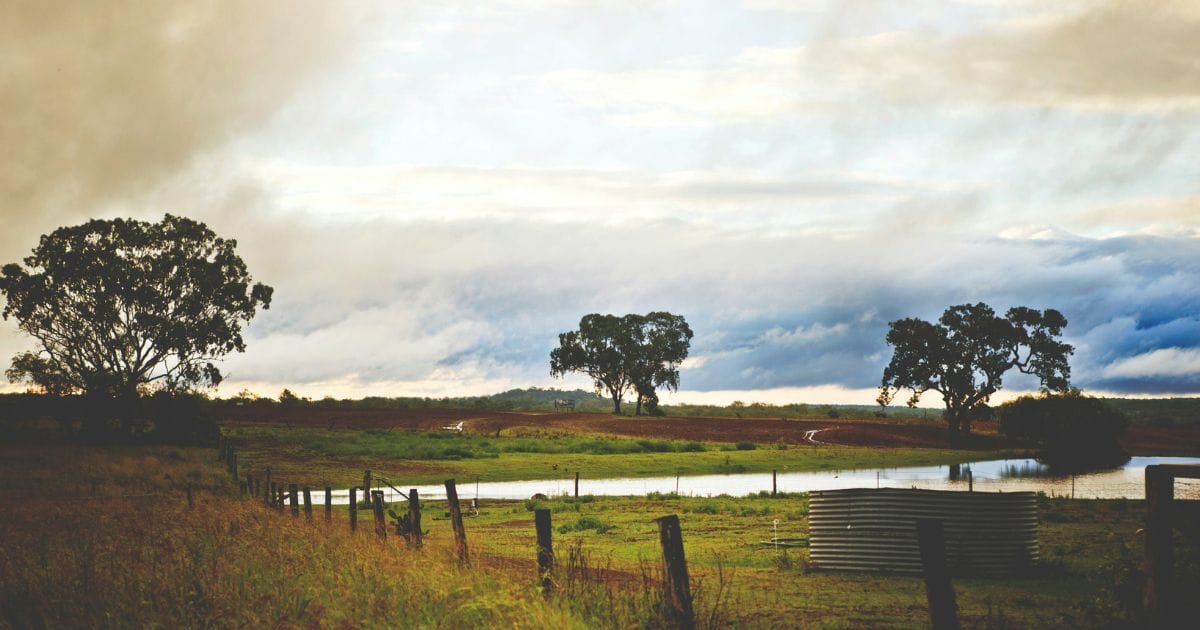It’s been raining consistently, so why are dam levels in West Vic still low?
Despite steady July downpours, dry soils and changing runoff patterns mean farmers are still watching water levels drop — and the science says it could get worse.

Despite the welcome sound of rain on roofs across the south west, the downpour isn’t translating to rising dam levels – and experts are warning it might not for some time.
Farmers across Western Victoria, already battered by two years of dry summers and failed autumns, are now facing the grim reality that even the consistent July rain may not be enough to replenish dwindling water supplies.
“It has been an exceptionally hot and dry year so far, and winter 2024 was dry too,” Dr Keirnan Fowler, Senior Lecturer in Hydrology and Water Resources at Melbourne University, told the Brolga. “So it’s been a while since our catchments have received a good soaking.”
The core issue, according to Fowler, is that soil acts like a sponge – soaking up water before it has a chance to run off into dams or creeks. And in many parts of the state, that sponge is bone dry.
“Just because it rains, it doesn’t automatically lead to streamflow for our dams,” he said. “It depends on how dry the soil is, and this depends on conditions we saw last week, last month, last year or even longer.”
The water table – which plays a key role in soil moisture – has declined significantly in parts of Western Victoria over the past 30 years.
Fowler said this long-term drop means catchments are slower to respond to rain than they were a generation ago.
“Since [the Millennium Drought], we’ve consistently seen less runoff for a given amount of rainfall,” he said. “Scientists phrase it as a ‘shift in the relationship’ between rainfall and runoff.”
For farmers, that shift is playing out in real time. Dixie dairy farmer and Dairy Farmers Victoria committee member Brad Collins said some farmers in the region were still running low.
“I do believe there’s been a bit of runoff,” he said. “I wouldn’t say they’ve filled their dams, but I think they’ve probably still got some water in their dams, so they’re okay at the moment – but they definitely need some rain through spring to make sure they can get through the next eight to 12 months.”
Agriculture Victoria Land Management Officer Clem Sturmfels said in a recent statement many dams are unlikely to fill this season without a thunderstorm directly overhead.
“Even in an average year, plenty of rain is required to fill farm dams,” Sturmfels said. “The rate of runoff varies from about five percent to 10 percent of annual rainfall, and the location, climate, soil type and ground cover all impact on this figure.”
And this is no average year.
Soil moisture remains “well below average” according to Sturmfels, with some deep, well-structured soils requiring upwards of 200mm of rainfall before reaching saturation – the threshold needed before meaningful runoff occurs.
The maths is not reassuring. A typical one megalitre dam needs a catchment area of five to 10 hectares, and even then, runoff will only occur once the soil stops absorbing water.
To help manage the shortfall, Agriculture Victoria is encouraging farmers to develop water budgets and consider infrastructure improvements such as contour banks – small earth ridges designed to increase the catchment area of dams.
Collins said many farmers were already making similar adjustments at a practical level.
“A lot of people have destocked, they’ve cut back on cows, they probably haven’t been cleaning their facilities like their yards as much, just to save that water,” he said.
“But they’ve also taken advantage of actually cleaning out their dams so that when they do fill up, they’re going to fill with more capacity. Anyone [who’s] relying on dam water has been on fairly constant watch, and they’ve had to adjust their businesses to try and suit what water they do have.”
In the longer term, Fowler believes the impacts of climate change caused by increased carbon emissions and fossil fuels are already rewriting the rules of water security in the region.
“In most areas of Victoria and Australia we can see warming trends leading to drier soils, and thus more rain is needed to generate the same runoff,” he said. “Even though the Millennium Drought ended with large floods in 2010 and there’s been other floods since, these weren’t enough to ‘reset’ the catchments.”
Agriculture Victoria is currently seeking quotes from specialists including agronomists, livestock nutritionists and farm business advisors to deliver further consultations and workshops for south west farmers.
The hope, Linden said, is that sharing science-backed strategies – and connecting farmers through local events – will help communities stay resilient in the face of a future where “average rainfall” no longer means average outcomes.
Collins said while the region remained in a tough spot, some relief could be within sight.
“We’re probably four to six weeks away from a state where there will be some breathing room where the grass will grow,” he said. “They won’t catch up on all their bills, but they will be able to feed their cows without having to buy in so much feed.”
